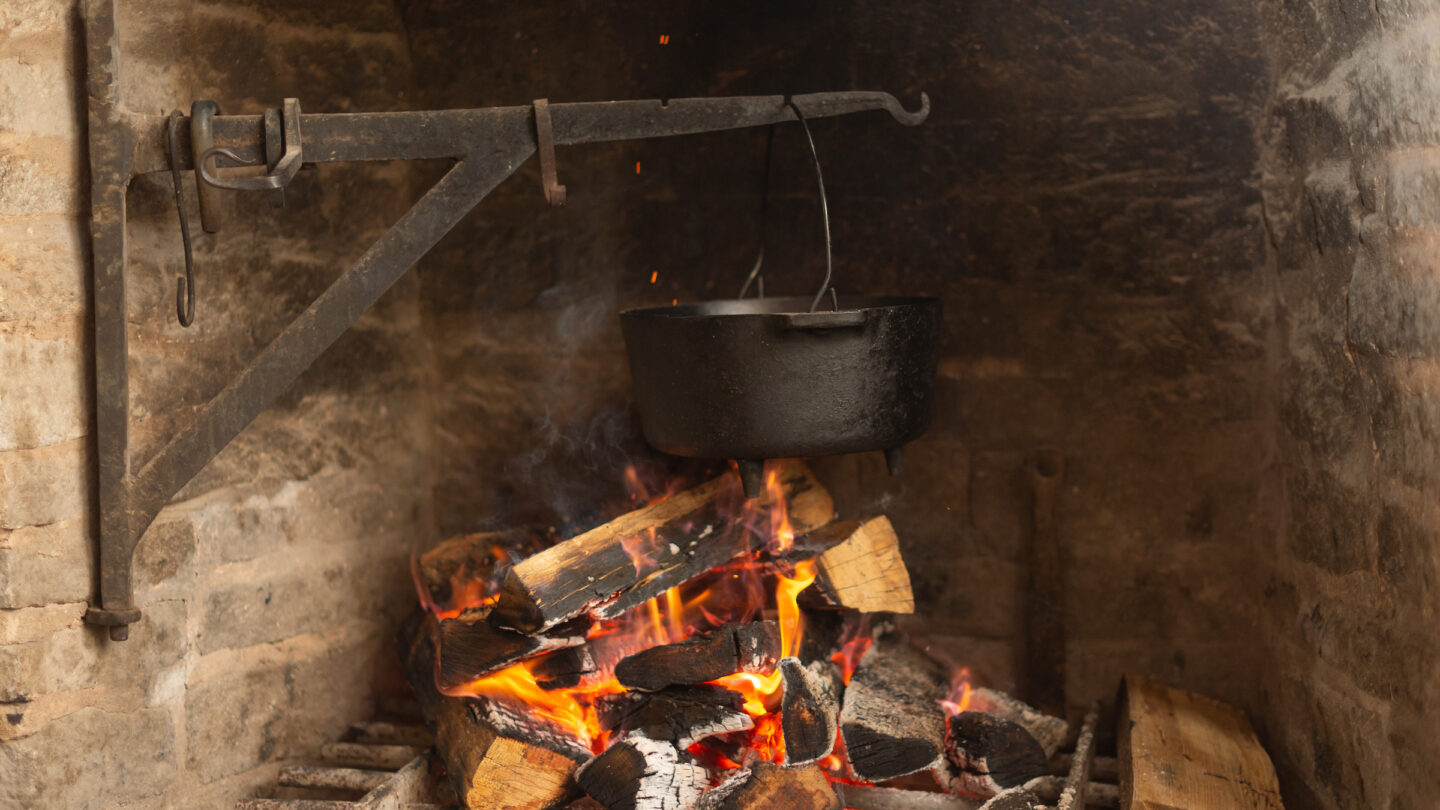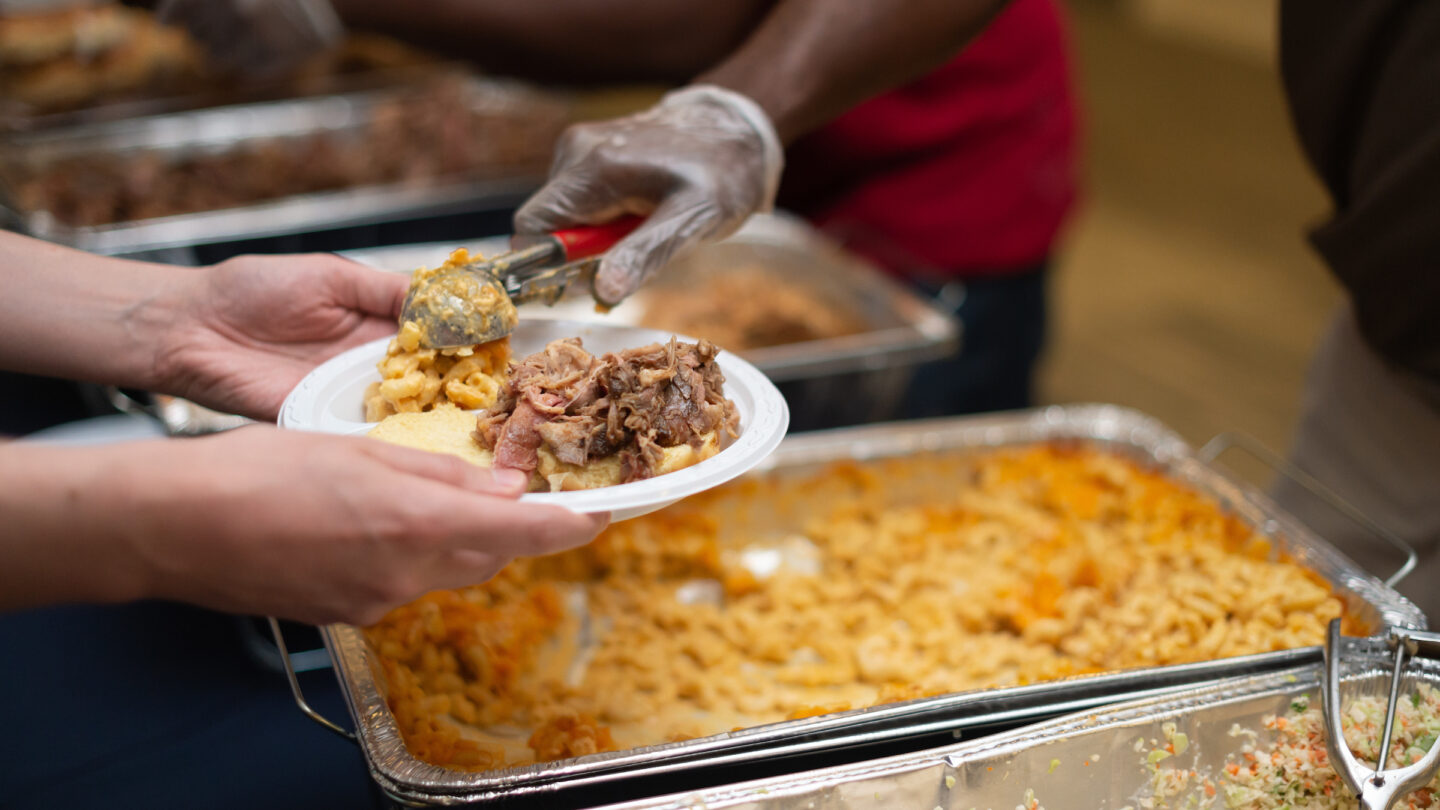
The cooking technique associated with barbecue is incredibly old. The word “barbecue” derives from a Spanish translation of the word the Caribbean Taino people used to describe a wooden structure they used to smoke meat—“brabacot.” The technique spread quickly to Europe, and from there back into the North American colonies. To the Spanish, it became “barbacoa,” and when it turned up in English in the 1600s, it had become “barbecue.” Variations of this early barbecue technique also continued to come north from the Caribbean. Many of the early barbecuers in what would become the United States were enslaved Africans who were sold north from the sugar islands and who combined their native cooking techniques with local barbecue know-how.
Barbecues weren’t a quick meal. Cooking took a long time, a lot of effort. Because of this, they became tied to large parties or celebrations that could be prepared for in advance, and that would have many hungry guests. This also meant that the people hosting barbecues had to have the money to pay for all that food. Before the Civil War, barbecues were typically held by the wealthy. George Washington, for example, enjoyed attending them. However, they were also occasionally hosted by enslaved people, albeit in secret. Barbecues were celebratory, delicious, and could dispose of a stolen pig or other foods in a single sitting. Washington’s participation speaks to another important part of barbecues’ history; they were often tied to political events. They helped to unify and educate newly emancipated Black voters during Reconstruction, and in the twentieth century, future President Lyndon B. Johnson used large barbecues to shore up support during his campaign. Barbecue doesn’t just give us a window into the history of the formation of the United States or its political history. The barbecue of today is the product of the blending of the numerous different traditions of the many cultural groups who have roots in the southern United States. Though it continues to shift and change as we become more nationally and globally connected, the variations in barbecue techniques that exist across the region can tell us a great deal about the histories of the South and its population.
Meat
For example: It’s hard to have a barbecue without meat. The most common choice for barbecuers across the United States is certainly pork, which speaks to the eating habits of early Southerners. Pigs aren’t native to the Southern United States. They were brought by the Spanish in the early seventeenth century and were incorporated into the diets of many of the European settlers who established homes in the South. Pigs were a popular southern food source from the seventeenth century into the early twentieth century for several reasons. Raising pigs for their meat, particularly before the Civil War, required little to no infrastructure for managing them, or money to feed them. Most Southern farmers let their pigs range freely in the woods near their homes until it was time to butcher them. Once killed, much of a pig’s body was edible. What didn’t need to be eaten immediately was easy to preserve. For most of the year, many small farmers subsisted on cured meats like salt pork and bacon. Fat could be rendered down to lard, which could be used in many different dishes or household tasks. With a diet so focused on pork, it’s unsurprising that many Southern barbecuers developed their cooking techniques around this meat. Typically, pork shoulder was (and is) the preferred cut to barbecue, but particularly large events might see a whole hog barbecue.
There are, however, some important departures from the pork barbecue that remains popular throughout the South. Today, chicken has usurped pork as the most commonly eaten meat in the South, and it’s therefore an option on many barbecue menus. In Kentucky, which was once one of the largest sheep-producing states in the US, mutton is a popular barbecue meat. And in Texas, barbecue often includes beef or beef brisket—a reflection of Texas’ long history as a beef cattle farming state. Barbecued sausage and goat are also popular in Texas, reflections of the German and Mexican heritage of many of its inhabitants.

Sides
What’s served alongside a plate of barbecue can also tell us something about a region’s or state’s history. In Virginia and Georgia, Brunswick stew is a go-to barbecue side. This stew’s origins are debated—both Virginia and Georgia claim it. If it was developed in Virginia, it was first prepared by Black camp cook Jimmy Matthews and is made with a combination of meat, vegetables, spices, and stale bread. It is emblematic of early frontier cooking that would have been developing alongside barbecue. In some parts of North Carolina, Brunswick stew is also a popular barbecue side, but hushpuppies—fried balls of cornmeal and seasonings—become more common the closer you get to the coast. This is likely the result of their having been developed as an accompaniment to fried fish. The technique that is used to fry hushpuppies, the fish they were first served with, and most other fried foods in the South, reflects this side’s ties to Black American history. A pot of oil suspended over a heat source was regularly used to cook traditional West African foods like fried okra—small balls of black-eyed pea paste seasoned with onions and other spices.
The preferred barbecue side in South Carolina is hash. In many ways, it’s similar to Brunswick stew. It’s a pork-based stew seasoned with vinegar. But, rather than being served as a stew, barbecue hash is served over rice—the result of South Carolina’s history as a major producer of that crop before the Civil War. In Texas, potato salad is a common side, along with a slice of soft white bread for sopping up sauce and grease. Even sides that are typical across the South—like coleslaw—have regional variations. In North Carolina, for example, coleslaw sauces tend to be more vinegar based, while in Tennessee, they tend to be creamier, and include more mayonnaise.
Sauces
Barbecue is seasoned primarily by the addition of sauces, either during the preparation of barbecued meats, or while they’re being served. Like sides and meats, variations in barbecue sauces can reflect regional differences and histories. One of the earliest written European recipes for barbecue sauce looks a bit different from those we know and love today. It calls for wine, lemon juice, sage, red and black pepper, and salt. Over time, this recipe evolved, and was changed by generations of cooks from across the world. West African cooks in particular had an impact, combining their native sauce and rub-making techniques with existing smoking strategies. Spices and herbs like sage and pepper often remain in modern barbecue sauces, but wine and lemon juice have been replaced by condiments like mustard or vinegar. Today, much of what we know as barbecue sauce reflects the sauces that were developed in Tennessee. Their base relies on ketchup and molasses and creates a thick brown sauce. But, in North Carolina, vinegar is the preferred sauce base. Apple cider vinegar is particularly popular. Cider vinegar would have been a household staple for many early North Carolina settlers, who used it as both a seasoning and a preservative. This base produces a more liquid sauce that is often mixed into meat as it’s chopped or pulled, rather than served on the side for diners to pour over their barbecue. This reflects British cooking practices—basting, in particular.
Pockets of South Carolina prefer mustard-based sauces, sometimes called “Carolina Gold” sauces. The use of mustard as the primary condiment in these sauces is the product of large French and German immigrant populations in the area. Both of these groups used mustard regularly in their traditional cuisines and, as a result, helped shape their region’s barbecue. Some innovations in barbecue sauce’s development are a bit easier to track. Alabama’s famous mayonnaise-based “white sauce” for example, was developed in 1925 by Robert Gibson.
Drinks
Barbecue itself can clearly tell us a great deal about the history of the South, but so can the things that often come with it. Drinks are an excellent example. Lemonade and sweet tea, Southern classics, both originated as ways to keep cool in hot summer weather that also had the benefit of making water safe to drink by boiling before the age of germ theory. Soft drinks, often served with modern barbecue, also have a special relationship with the South. Coca-Cola was developed right here in Georgia. Pepsi Cola originated in North Carolina, Mountain Dew came to be in Tennessee, and Barq’s Root Beer was born in Mississippi. After they started to be served cold, these drinks helped combat the heat of southern summers. Their high caffeine content also helped bolster their popularity, particularly among factory workers with long hours who needed to keep alert.
Desserts
Though not all barbecues include desserts, many do, and the celebratory meals with which barbecues share much history are filled with them. These desserts, too, vary across regions, and speak, much like barbecue, to their agricultural and social history. Peach cobbler, a Georgia classic, is an excellent example. Cobbler itself is the product of early English settlers finding ways to make pastries without ingredients they relied on in England, like suet. Cobbler’s classic fruit fillings vary regionally. In Georgia, and much of the Deep South, stone fruits, like peaches, grow easily and produce lots of fruit. Thus, they’re a very popular cobbler filling. However, in the Upper South, particularly in Appalachia, peaches and other stone fruits are much less successful. There, you’re more likely to come across seasonal berry cobblers, or maybe even an apple pie. When it comes to pies, Key Lime pie tells us a great deal about its Florida origins. Its flavor speaks not only to the delicious limes that grow in the Florida Keys, but also to the difficulties of preserving dairy products in such a hot environment before refrigeration. Key Lime pie relies on tinned condensed milk, rather than fresh. Pecan pie, on the other hand, demonstrates a more broad Southern history. Its early origins are likely British, but pecan pie itself was first developed in the early twentieth century, when pecans were cheap and easy to get, and corn syrup was a novel new ingredient.

